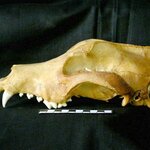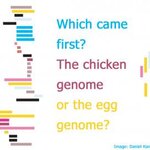Evolution

It's historically been the case that fossil remains of Neanderthals paint an incomplete picture; they can't tell us about their cognitive skills or really give us details of what they looked like.
But scientists at the Max Planck Institute in Leipzig started looking into the DNA of Neanderthals and they made some astonishing discoveries. They discovered the human variant of the FOXP2 gene in our nearest relatives and an interesting detail: at least one percent of the Neanderthals in Europe may have had red hair.
Only two percent of the world's population have naturally red hair - caused by a…

The St Bernard dog – named after the 11th century priest Bernard of Menthon – may have ironically challenged the theory of creationism, say scientists.
Biologists at The University of Manchester say that changes to the shape of the breed’s head over the years can only be explained through evolution and natural selection.
The team, led by Dr Chris Klingenberg in the Faculty of Life Sciences, examined the skulls of 47 St Bernards spanning 120 years, from modern examples to those of dogs dating back to the time when the breed standard was first defined.
St. Bernard 1892. The angle between the…

By peering deep into evolutionary history, scientists at the University of California, Santa Barbara have discovered the origins of photosensitivity in animals.
The scientists studied the aquatic animal Hydra, a member of Cnidaria, which are animals that have existed for hundreds of millions of years. The authors are the first scientists to look at light-receptive genes in cnidarians, an ancient class of animals that includes corals, jellyfish, and sea anemones.
“Not only are we the first to analyze these vision genes (opsins) in these early animals, but because we don’t find them in earlier…
Were Neanderthals direct ancestors of contemporary humans or an evolutionary side branch that eventually died out?
This is one of the enduring questions in human evolution as scientists explore the relationship of fossil groups, such as Neanderthals, with people alive today.
The simultaneous publication of two studies with Neanderthal nuclear DNA sequences [1,2] was a technological breakthrough that held promise for answering a longstanding question in human evolution: Did “archaic” groups of humans, such as Neanderthals, make any substantial contribution to the extant human gene pool? The…

Embryologists at University College London have helped solve an evolutionary riddle that has been puzzling scientists for over a century. They have identified a key mechanism in the initial stages of an embryo's development that helps differentiate more highly evolved species, including humans, from less evolved species, such as fish.
Early on in development, the mass of undifferentiated cells that make up the embryo must take the first steps in deciding how to arrange themselves into component parts to eventually go on to form a fully developed body. This is a process known as 'gastrulation…

An extraordinary advance in human origins research reveals evidence of the emergence of the upright human body plan over 15 million years earlier than most experts have believed. More dramatically, the study confirms preliminary evidence that many early hominoid apes were most likely upright bipedal walkers sharing the basic body form of modern humans.
The report is based on research from Harvard University’s Museum of Comparative Zoology and from the Cedars Sinai Institute for Spinal Disorders that connects several recent fossil discoveries to older fossils finds that have eluded adequate…

Which came first, the chicken genome or the egg genome?
Researchers have answered a similarly vexing (and far more relevant) genomic question: Which of the thousands of long stretches of repeated DNA in the human genome came first? And which are the duplicates?
The answers, published online by Nature Genetics on October 7, 2007, provide the first evolutionary history of the duplications in the human genome that are partly responsible for both disease and recent genetic innovations. This work marks a significant step toward a better understanding of what genomic changes paved the way for…

two closely related bird species, the collared flycatcher and the pied flycatcher, can reproduce with each other, but the females are more strongly attracted to a male of their own species. This has been shown by an international research team directed by Anna Qvarnström at Uppsala University in today’s Net edition of Science. They demonstrate that the gene for this sexual preference is found on the sex chromosome that is inherited from the father and that only females have a copy of. The discovery sheds new light on how new species are formed.
The formation of new species takes millions of…

Scientists at the University of Missouri-St. Louis used DNA sequences from feather lice to study how island populations of their host, the Galápagos Hawk might have colonized the Galápagos islands, home to the endangered and declining raptor.
The study, focuses on genes from three parasite species restricted to the Galápagos Hawk. The scientists also sequenced the same genes in the hawk to compare levels of genetic variation across these distantly related species. They traced the family tree of each species across the eight-island range, which were each colonized by the hawks and its…

Chips from 10 million years ago have revealed new insights into fish diets and their influence on fish evolution, according to new research. The chips were found, along with scratches, on the teeth of fossil stickleback fish and reveal for the first time how changes in the way an animal feeds control its evolution over thousands of years.
This kind of study, which was funded by the Natural Environment Research Council, has previously not been possible because although fossils preserve direct evidence of evolutionary change over thousands and millions of years, working out exactly what a long…